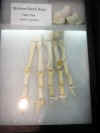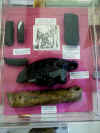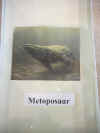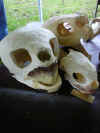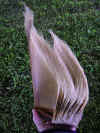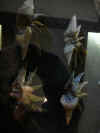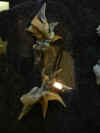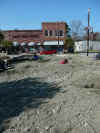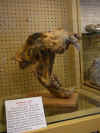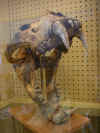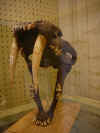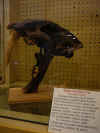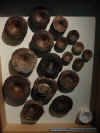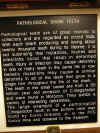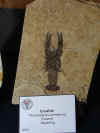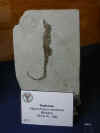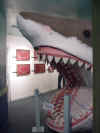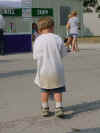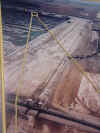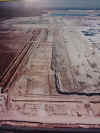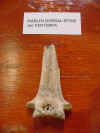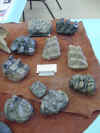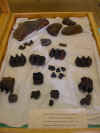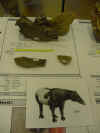You are on: Fossils Page 9
Click To Go To:
Fossils Page 1 Page 2 Page 3 Page 4 Page 5 Page 6 Page 7 Page 8Page 10 Page 11 Page 12 Page 13 Page 14
(TABLE OF CONTENTS ON PAGE 1)
Contents: Aurora and Ocean Lakes FOSSIL FESTIVALS, and Fossil Identification Photos
|
AURORA FOSSIL FAIR - FESTIVAL 2010
WAS HELD ON MAY 28-29 THIS YEAR (Memorial Day weekend each year) Here is a link to the Aurora Fossil Museum website (Events link):
aurorafossilmuseum.com
& NC Office of Environmental Education website with more information on the 2008 show events:
|
|
AURORA FOSSIL FAIR
May 23, 2009 Photo of phosphate excavation equipment in the park across from the Museum |
|||
| New fossils from the Club to share, to assist with identification | |||
| Black bear (Ursus americanus), right molar; Cope's Tapir, upper & lower molar and lower incisor | Black bear, last upper right molar and lower left molar | Modern black bear, rear paw, North Carolina | Long-nosed peccary (Mylohyus sp. nasutus, lower left molar teeth |
| Pinckney's Capybara (Neochoerus pinckneyi), cheek tooth and incisor | Comparison of teeth: Polar bear, squalodon, archeocete, cave bear | Comparison of teeth: panther, prosqualodon, dire wolf, seal, and porpoise | Seal femur, radius, metacarpal, metatarsal and phalunge |
| Shasta ground sloth teeth, claw core and partial rib | Manatee partial lower jaw, and vertebrae | Small wolf or red wolf (Canis rufus), Navicular (foot bone), premolar tooth, and astralagus bone | Metoposaur drawing, and lower & upper jaw sections |
| Link to view George Powell, sharing with us a partial whale skeleton he is restoring, in a garage just off the main street, during the show: | |||
|
MAY 2008
AURORA FOSSIL FESTIVAL Here's Heidi at the fest, and a surprise meeting with a website customer she invited by email to come that CAME! Moe said he's really glad he came. |
|||
| SCIENCE TENT | |||
| Science studies explained in one tent, these are turtle skulls | Nurse shark jaw | Whale vertebrae | Whale baleen |
| FOSSIL CLUB DISPLAYS | |||
| Thanks to George Powell, here are fossil shark teeth as they would grow within the jaw. | Whale vertebrae in matrix |
Fossil dolphin shark teeth
Extinct toothed whale teeth |
|
| New in the LEARNING CENTER | |||
|
CROC JAWS (Gavialosachus Americanus)
Associated fossil crocodile upper/lower jaws A second set of croc jaws |
|||
| MEMORIAL DAY PARADE, AURORA | |||
| First Parade banner | Great shark float! | Gator golf cart (Sudan Gators) | Keystone Kops |
| Clowns | |||
| THE AURORA PHOSPHATE MINE | |||
| Driving out of town, we snapped a few photos of the mine operation | |||
|
VISIT MARCH 2008
AURORA, NORTH CAROLINA AURORA MUSEUM |
|||
|
On our way back from New York, we made an unexpected stop in Aurora. There were people digging in the phosphate pile in the center of town, even in the early spring cold.
Plenty of information to identify the fossils you find, and general rules to respect the area and others: Glenn, next to the huge great white shark jaw inside the museum: A new fossil toothed whale exhibit, not from the phosphate mine, is a great display. The museum purchased it for $40,000, dated to the Miocene age, 5-23 million years old. Undetermined Odontocete species, excavated by Matty Swilp, South Carolina. Whale measures nearly 15 feet long (20 feet when alive), closer to a relative of the modern sperm whales rather than the "shark toothed" whales. It apparently had a hard life - its teeth were very worn, and there is evidence of healed rib fractures on the left side and gouges in some of the bones perhaps bite marks: |
|||
| The Fossil Exhibits "Learning Center" building has been getting some great specimens to display, see what I've posted below | |||
| Fossil turtle shell | toothed whale teeth | Mosasaurus teeth & jaw | Anapsid reptile (Captorhinus magnus) |
| American Lion skull (Panthera atrox) | |||
| Saber tooth cat (Smilodon Fatalis) | |||
| Megalodon shark vertebrae, compared to a great white shark vertebrae (white, in corner) | Mastodon jaw |
Primitive "Scissor-Jawed" Shark
Edestus heinrichi
|
Pathological megalodon shark teeth |
| Associated shark vertebrae disks | Shark cartilage | Shark coprolite (poop!) | Shark nose |
| Whale humerus | Whale beak | Walrus femur | Walrus ankle bone |
| Monk Seal Femur | Monk Seal Humerus | Walrus skull & tusks | Various whale teeth |
| Whale mastoid process, sperm whale tooth, Pilot whale jaw segment, and baleen whale flipper (finger) | Crawfish (procambarus primaevus) | Garpike | Crab (Harpacto xanthopsis quadrilobatus) |
| Seahorse (Hippocampus ramulosus | Dragonfly Larvae (Liebulla doris) | Frog (Rana?) | Rhinoceras Teeth/jaw (Teleoceras fossiger) |
| Rhino horn | Shrimp, Ammonite, Brittle Star (Aeger tipularis, Subplanites, Saccocoma tenellum) | Dragonfly (Protolindenia sp.) | Water Strider (Cresmoda obscura) |
| Lobster-like decapod (Cycleryon propinquus) | Crab (Avitemossus grapsoides) | Bird feather (Aves sp.) | Stingray (Heliobatus radians) |
|
AURORA FOSSIL SHOW 2003 the free sand pile to dig for fossils...
This young man REALLY took advantage of the pile of phosphate in looking for fossils in the pile... Another enthusiastic fossil pit "diver" ADULT with a dirty behind that we KNOW enjoyed the show and found some great fossils too! ... (Above) Here's a little sweetie that enjoyed the fossils in our booth at the show - and WE enjoyed the shark backpack she had. It turns out this was a gift to her when she had to go into the hospital for her fifth brain surgery. A great gift for a tough little trooper. Above is a good example of an Aurora megalodon tooth. Only the portion showing above Ken's hand is what was found, the rest was restored by a master. So it does not have the same value as an original tooth but sure is a beauty! |
|
AURORA NC FOSSIL MUSEUM |
|
Megalodon shark jaw model (from both ends!)
A list of Man Eating Sharks Photographs of the phosphate mine and a model of a cross section of the mine showing layers of fossils. Ore being slurried for pumping. This material is FULL of fossils that get sucked into the transport tubes up to 11 miles long A great summary of the mine operation and the fossil layers found there: On the south shore of the Pamlico river in North Carolina near the Outer Banks lies an open pit phosphate mine still in operation. This mine produces some of the finest fossil shark teeth in the world and the region is known as "Lee Creek" by most. There are four recognized formations each with its respective representation of an epoch in time. They are in order of oldest first, PUNGO RIVER (Lower Miocene), YORKTOWN (Early Pliocene), CHOWAN RIVER (Late Pliocene), and JAMES CITY (Pleistocene). It is currently believed that the Pungo River layer once existed as a sub-tropical marine environment. The lowest strata of this formation is theorized to have been under 100 - 200 meters of water when covered by a prehistoric ocean with the uppermost layer having existed at a depth of 70 meters under water. The Yorktown layer is believed to have been under 80 - 100 meters at its lowest strata with a gradual decrease in the ocean depth to a point where the water was as shallow as 15 meters at the last time period of that formation's existence. Approximately 50 species of sharks alone are found in the Lee Creek mine. Other fossils exist representing skates, rays, bony fishes, mammals (mainly marine), reptiles (turtles) and a host of marine invertebrates. Lee Creek is a world-class site for some of the finest shark fossils. These specimens are coveted by collectors the world over. All it takes is to hold one of these gem teeth in your hand and behold the beauty up close and personal. In doing so, you too, will be hooked forever on the beauty of Lee Creek teeth. |
|
Below is our great Fossil Identification showcase in our store (now in our home). Some are unusual fossils, others are more common fossils found right here on our own Myrtle Beach and surrounding areas. Folks came from near and far with their fossils to find out what they are. We've got reference books to back up the display as well, we're delighted to see what everyone has found. (See the Weirdest pages for a great Weird Museum we've set up of our MOST unusual collections). |
|
FOSSIL TURTLE HEADS on Myrtle Beach? For those of you, such as our good customer here, who have found these "fossil turtle heads" on Myrtle Beach, particularly after a big storm or from dredging, we've got bad news for you... It's actually the 60 million year old fossilized snail (or rock-like cast) formed by silt that replaced the snail from an extinct Cucullaea, which is a mollusk similar to a modern-day Ark shell. Here's a photo of the full shell (below) so you can picture the "turtle head" inside it. |
|
The April 3, 1997 Sun News (Myrtle Beach, SC) ran an article entitled: "Man identifies Strange objects found on Beach". The essence of the article is that along with thousands of sand dollars, whole seashells and other sea treasures that waves have sucked off the ocean floor and deposited on the beach, there have been hundreds of casts of clam shells from 60 million years ago. Sometimes you can find one with the shell still on it. People think they are fossilized turtle heads. Another North Myrtle Beach resident, Richard E. Petit, a research associate with the Smithsonian Institute, said the molds were formed inside Cucullaea, a mollusk that became extinct in this part of the world around 60 million years ago. The rocklike forms people are finding on the beach that look like miniature stone turtle heads were formed when the empty Cucullaea shells filled with fine silt, which hardened over the millennia. Eventually the shells broke off, leaving only the rock-like casts. The casts have a spiny ridge on the rounded top-side, an indent that looks like the place where a spine might attach and a line that looks like where the mouth would close. That is why they resemble fossil turtle skulls. But sadly they are not. |
Click To Go To:
Fossils Page 1 Page 2 Page 3 Page 4 Page 5 Page 6 Page 7 Page 8Page 10 Page 11
(TABLE OF CONTENTS ON PAGE 1)






